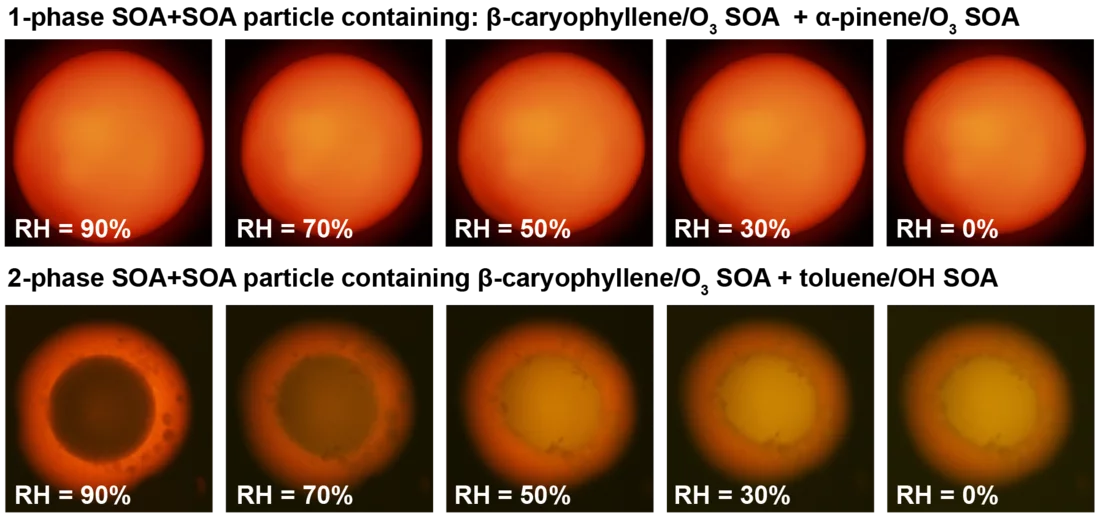Peering inside atmospheric particles provides clues to effects on climate and health, finds Paul Scherrer Institute and University of British Columbia study.
Not all aerosol particles in the atmosphere are released directly as particulate matter: some are formed in the atmosphere from precursor gases that are released from a variety of natural and manmade sources including forests and traffic emissions. Known as secondary organic aerosols (SOAs), these particles are ubiquitous in the atmosphere and play an important role in air quality and climate. They contribute to air pollution, affecting human health, and can deflect solar radiation or aid cloud formation, impacting climate.
Different types of SOAs can mix together within the same aerosol particles. The environmental impacts of such mixed SOA particles are governed by the particles’ physical and chemical properties, particularly the number of phases—or states—they can exist in.
In a new research letter published in the open access journal Atmospheric Chemistry and Physics, an international team of researchers has found that particles with two phases can form when different types of SOAs mix. The finding could help improve current models predicting SOA climate and health effects.
“Up until now, models have often assumed that when SOA types mix into the same particle, they have just one phase. But we found that’s not always the case, meaning current models might not correctly capture some of these effects,” says Dr. Fabian Mahrt, a postdoctoral fellow at the Paul Scherrer Institute and the University of British Columbia and lead author of the study, which is funded by the European Union’s Horizon 2020 research and innovation program.
The team found that six out of 15 mixtures of two SOA types commonly found in the atmosphere resulted in two-phase particles. Importantly, they also discovered that the number of phases depends on the difference in the average oxygen-to-carbon ratio between the given SOA types. It’s a fairly simple but potentially powerful way to represent such effects in models. When this difference is 0.47 or higher, the researchers found particles would have two phases.
“Now we can work with very complex organic molecules, calculate a single parameter which gives us information about the properties of a particular SOA mixture, and then potentially map quite large-scale impacts,” says aerosol scientist and senior author Dr. Allan Bertram, professor at the University of British Columbia.
This kind of SOA mixing might occur include when plumes of SOA particles, which have been in the atmosphere for some time, blow from rural environments over cities where newly produced SOA particles are being emitted, says Dr. Mahrt.
“If we assume this mixing of the plumes forms particles with a single phase, we might over-predict the total organic particulate mass in these areas, and so, the effects on those people’s health.” The team of scientists hopes the finding can help improve models and ultimately ensure that policies and regulations are based on a rigorous scientific understanding.
Building on previous work, the researchers used fluorescence microscopy to look inside the mixed SOA particles in their current experiments, injecting them with a dye that causes the particle phases to emit different coloured light depending on their polarity. The researchers then used these colours to directly infer the number of phases of the mixtures, providing a direct visual proof of multiple phases.
The research team hopes other scientists will now extend the number of SOA mixtures experimentally, as well as include the findings in atmospheric models going forward.
“The study is evidence that we need to look at this phenomenon more carefully to get the full picture. We have one more piece of the puzzle but we’ve not necessarily finished the jigsaw yet,” says Dr. Mahrt.
Text: Based on a press release from University of British Columbia with additions from Paul Scherrer Institute/ Miriam Arrell
Contact
Prof. Dr Markus Ammann,
Head of Surface Chemistry Research Group,
Paul Scherrer Institut, Forschungsstrasse 111, 5232 Villigen PSI, Switzerland
Telephone: +41 56 310 40 49, e-mail: markus.ammann@psi.ch
Original Publication
Not all types of secondary organic aerosol mix: two phases observed when mixing different secondary organic aerosol types
Fabian Mahrt, Long Peng, Julia Zaks, Yuanzhou Huang, Paul E. Ohno, Natalie R. Smith, Florence K. A. Gregson, Yiming Qin, Celia L. Faiola, Scot T. Martin, Sergey A. Nizkorodov, Markus Ammann, and Allan K. Bertram
Atmospheric Chemistry and Physics 1st November 2022
https://acp.copernicus.org/articles/22/13783/2022/,
Copyright
PSI provides image and/or video material free of charge for media coverage of the content of the above text. Use of this material for other purposes is not permitted. This also includes the transfer of the image and video material into databases as well as sale by third parties.


